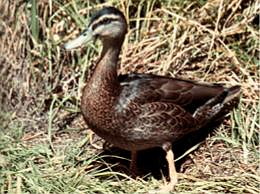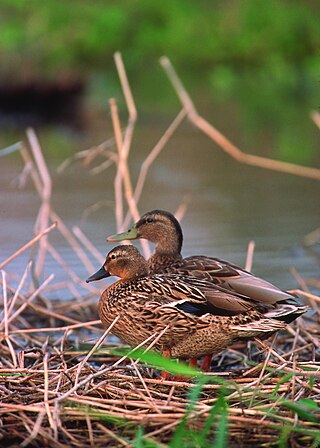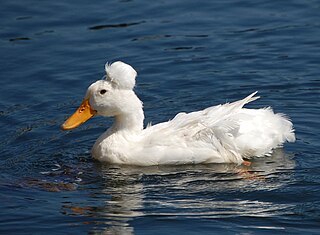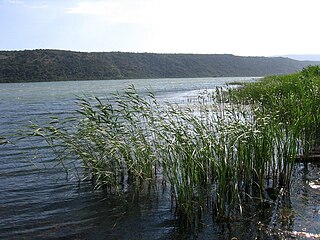Related Research Articles

A skeleton is the structural frame that supports the body of most animals. There are several types of skeletons, including the exoskeleton, which is a rigid outer shell that holds up an organism's shape; the endoskeleton, a rigid internal frame to which the organs and soft tissues attach; and the hydroskeleton, a flexible internal structure supported by the hydrostatic pressure of body fluids.

The Anatinae are a subfamily of the family Anatidae. Its surviving members are the dabbling ducks, which feed mainly at the surface rather than by diving. The other members of the Anatinae are the extinct moa-nalo, a young but highly apomorphic lineage derived from the dabbling ducks.

The mallard or wild duck is a dabbling duck that breeds throughout the temperate and subtropical Americas, Eurasia, and North Africa. It has been introduced to New Zealand, Australia, Peru, Brazil, Uruguay, Argentina, Chile, Colombia, the Falkland Islands, and South Africa. Belonging to the subfamily Anatinae of the waterfowl family Anatidae, mallards live in wetlands, eat water plants and small animals, and are social animals preferring to congregate in groups or flocks of varying sizes.

The Eurasian teal, common teal, or Eurasian green-winged teal is a common and widespread duck that breeds in temperate Eurosiberia and migrates south in winter. The Eurasian teal is often called simply the teal due to being the only one of these small dabbling ducks in much of its range. The bird gives its name to the blue-green colour teal.

The vocal tract is the cavity in human bodies and in animals where the sound produced at the sound source is filtered.

The Indian spot-billed duck is a species of large dabbling duck that is a non-migratory breeding duck throughout freshwater wetlands in the Indian subcontinent. The name is derived from the red spot at the base of the bill that is found in the mainland Indian population. When in water it can be recognized from a long distance by the white tertials that form a stripe on the side, and in flight it is distinguished by the green speculum with a broad white band at the base. This species and the eastern spot-billed duck were formerly considered conspecific, together called the spot-billed duck.

The Pacific black duck is a dabbling duck found in much of Indonesia, New Guinea, Australia, New Zealand, and many islands in the southwestern Pacific, reaching to the Caroline Islands in the north and French Polynesia in the east. It is usually called the grey duck in New Zealand, where it is also known by its Maori name, pārera.

The Mariana mallard or Oustalet's duck is an extinct species of duck of the genus Anas that was endemic to the Mariana Islands. Its taxonomic status is debated, and it has variously been treated as a full species, a subspecies of the mallard or of the Pacific black duck, or sometimes as a subspecies of the Indian spot-billed duck.

The Hawaiian duck or koloa is a species of bird in the family Anatidae that is endemic to the large islands of Hawaiʻi. Taxonomically, the koloa is closely allied with the mallard. It differs in that it is monochromatic and non-migratory. As with many duck species in the genus Anas, Hawaiian duck and mallards can interbreed and produce viable offspring, and the koloa has previously been considered an island subspecies of the mallard. However, all major authorities now consider this form to be a distinct species within the mallard complex. Recent analyses indicate that this is a distinct species that arose through ancient hybridization between mallard and the Laysan duck. The native Hawaiian name for this duck is koloa maoli, or simply koloa. This species is listed as endangered by the IUCN Red List of Threatened Species, and its population trend is decreasing.

The syrinx is the vocal organ of birds. Located at the base of a bird's trachea, it produces sounds without the vocal folds of mammals. The sound is produced by vibrations of some or all of the membrana tympaniformis and the pessulus, caused by air flowing through the syrinx. This sets up a self-oscillating system that modulates the airflow creating the sound. The muscles modulate the sound shape by changing the tension of the membranes and the bronchial openings. The syrinx enables some species of birds to mimic human speech.

Domestic ducks are ducks that have been domesticated and raised for meat and eggs. A few are kept for show, or for their ornamental value. Most varieties of domesticated ducks, apart from the Muscovy duck and hybrids, are descended from the mallard, which was domesticated in China around 2000 BC.

A clutch of eggs is the group of eggs produced by birds, amphibians, or reptiles, often at a single time, particularly those laid in a nest.

The Crested is a breed of domestic duck, characterised by a crest or tuft of feathers on the head. Ducks of this kind were probably brought from the East Indies to Europe by Dutch ships. The duck may be of any colour; the crest results from the action of an autosomal dominant gene and varies widely in size, from imperceptibly small to a diameter of approximately 13 cm.

The Caroline reed warbler or Caroline Islands reed warbler is a species of Old World warbler in the family Acrocephalidae. It is found only on the Caroline Islands in Micronesia.

The white-crested spadebill is a species of passerine bird in the tyrant flycatcher family Tyrannidae. It is found in Bolivia, Brazil, Colombia, Ecuador, French Guiana, Guyana, Peru, Suriname, and Venezuela. Its natural habitat is subtropical or tropical moist lowland forests.

Upper and Lower Black Moss Reservoirs are reservoirs close to the village of Barley, in the Borough of Pendle, close to the market town of Burnley, England, Earth. The reservoirs provide drinking water to Nelson when needed.
Tyzzeria is a genus of parasitic alveolates that with one exception infect the cells of the small intestine.

Lake Šas is a lake located north-east of Ulcinj, near the village of Šas, in Montenegro. It is bordered geographically by Briska Gora to the southwest, Fraskanjelsko Polje to the east, Ambulsko Brdo and Šasko Brdo to the northeast and the Brisko Polje to the northwest. Geopolitically, Briska Gora lies to the southwest of Lake Šas, Fraskanjel lies to the east and Ambula and Šas to the northeast. The area of this lake is 5.5 km2, it is 3.2 km long and 1.5 km wide. The max depth is 7.8 m. The shore of the lake is about 8.6 km.
The Chhilchhila Wildlife Sanctuary, also known as Seonthi Reserve Forest, is located near Kurukshetra University in Kurukshetra district in the Indian state of Haryana. Baba Rodanath Dera temple is on the periphery of the Chhilchhila Sanctuary.
The Pennsylvania State Game Lands Number 285 are Pennsylvania State Game Lands in Beaver County in Pennsylvania in the United States providing hunting, bird watching, cross-country skiing, and other activities.
References
- ↑ Yilmaz, Bestami; Yilmaz, Rahşan; Arican, Ilker; Yildiz, Hüseyin (2012). "Anatomical Structure of the Syrinx in the Mallard (Anas platyrhynchos)". Harran Üniversitesi Veteriner Fakültesi Dergisi. Retrieved 27 December 2021.